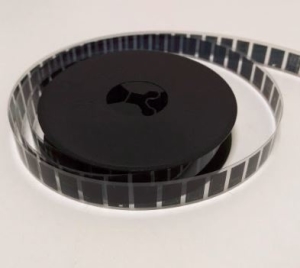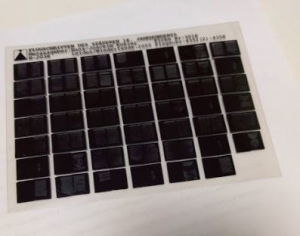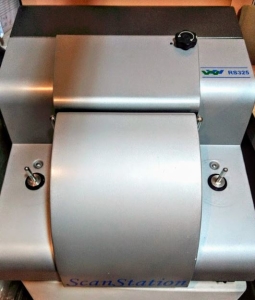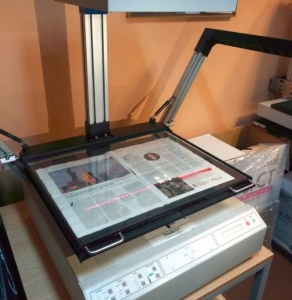Microfilm vs microfiche is about the differences and similarities between the 2 technologies. Manufacturers usually deliver microfilm on reels. They spool microfilm on 16mm or 35mm reels. Microfiche is 105mm by 148mm in size and comes in sheets. The technology to write on them is more or less identical.
Machines are different based on purpose though. Microfilm writers are built with spool movement in mind. They roll the film to expose it. A microfiche writer has to move the fiche support when writing it. They are both part of the microform and micrographic family of products.
Similarities and differences on microfilm versus microfiche
As we mention through this article, there are aspects which are similar between the two. But there are also differences between the two implementations. In this paragraph, we will analyze each one of them.
What are the similarities of microfilm and microfiche
- They are both micro-graphic products and store documents at different reductions.
- Reduction sizes are more or less similar for both.
- You can expose to both negative and positive image polarity.
- Fixer and developer are both of great use for both products when you process film.
- They are both used in the archiving industry.
What is the difference between microfiche and microfilm?
The main difference between microfiche and microfilm, is that microfiche comes in sheets, usually 105x148mm in size, while microfilm, 16mm or 35mm is spooled on reels and has a length of 30.5m or 66m.
- Microfiche is recommended for batches of documents that are up to 100 sheets. For example personal or financial folders and especially patient records, especially sheets that need to be stored separately.
- Microfilm is better for documents that can be stored together on the same reel. For example batches with a smaller number of documents, but in larger total quantities.
- The storage capacity of a microfiche is around 100 sheets, while a microfilm roll can store up to 6000 A4 sheets.
- While the exposure technology may be similar, the machines that write microfilm and microfiche are totally different.
Advantages of microfilm
While microfiche can store a decent amount of documents, microfilm can go up to 5000. The storage capacity of microfilm is a huge plus for microfilm. Because it is spooled, it also makes microfilm harder to damage or even lose. The process is also much more productive when writing. It is easier to write 100.000 documents to microfilm than it is to microfiche.
Because of it’s fixed size, storage capacities are easier to build. They are also more efficient. When buying a microfilm storage capacity, you will immediately know the storage capacity in the number of documents. Scanners are also more widespread, and retrieval can be quicker for microfilm. Please check our other article on advantages of microfilm.
Advantages of microfiche
Microfiche is definitely easier to view. Because it is sheet based, most viewers don’t require complex carriers. Also, it is much more effective for smaller batches of documents. For example, most patient files you can write to microfiche. This way, a microfiche contains a single patients documents.
When considering a microfilm roll, it would require putting a lot of patient files on the same roll. Also, car manufacturers have used microfiche for service interventions procedures or parts. They would deliver a microfiche folder for their dealers with all the details. At the same time, it was easier for them to damage or lose them. This was the main disadvantage of the microfiche.
Microfiche reader and conversion challenges
This is the real Achilles heel of microfiche. While the process itself is not that difficult, the supply of such scanners is reducing as we speak. The price for such services is quite high, because of its rarity. With the development of technology, currently, we are at a point in which we can optimize the retrieval process. But the main problem remains. It is still difficult and rare enough to be expensive.
Post-scanning you will face another problem. When you use microfiche, you will notice that you have a lot of small batches, with few documents. They will be difficult to index and also difficult to check for missed information. From writing to retrieving, we advice most customers to stay away from microfiche unless the need is critical. But if your project requires microfiche, that is the only way to go.
Digital microfiche machine for scanning or microfilm scanner
Both the above equipment handle conversion projects for customers. Professionals use them to scan microfilm or microfiche. The microfiche digital scanner works more or less like a standard document scanner. It feeds each microfiche, sheet by sheet and starts converting image by image. The microfilm scanner, on the other hand, turns the roll and captures frame by frame as the film moves.
Even though the microfilm contains more images, the capturing time could get to be similar on some machines. The more advanced machines will scan microfiche quicker than the older ones. But we think it is still not as straightforward as the case with microfilm scanners. Microfilm is more popular than microfiche, so manufacturers are focusing on that side of things. You will still find niche manufacturers that provide microfiche scanners.
How to read microfilm and microfiche without a reader
The main talking point of both microfilm microfiche is that you don’t need much to read them. Actually, you could read it with the naked eye. Still, you do need some tools. When laying the fiche flat on a white piece of paper, use a magnifying glass to read it. The higher the magnification of the glass, the more details you will be able to read. This makes it much easier if needed, to make a DIY reader for microfilm or microfiche.
Professional readers are actually very basic machines. Manufacturers are more focused on optimizing the entire process. The basic technology is not groundbreaking. Usually a powerful magnifying glass, a mirror and a light source from the back. The advance comes from microfilm microfiche handling. Making it easier to go through film or to move the microfiche around.
Is microfiche still used
We think archivists will limit applications in the future for both microfilm and microfiche. As we have seen lately, the use of microfilm and microfiche has generally decreased. But they are not dead yet. Archiving applications remain and we have seen an increase in the use of microfilm. Microfiche is still growing, but applications are decreasing day by day. There will always be a place for both.
We think microfiche will still work fine in the medical industry. While this is true, microfilm is growing in that same industry, because of the advances in indexing. Also, retrieval of microfilm is easier than retrieval of microfiche. So you should expect to use microfilm in some areas where it was the only microfiche. The lack of manufacturers in the microfiche industry is also not helping its cause.
Conclusions on microfilm vs microfiche
- Manufacturers deliver microfilm on rolls and microfiche on sheets.
- Microfilm is 16mm or 35mm in height, a standard microfiche is 105mm by 148mm.
- Based on reduction size, a microfilm can carry 5000 documents while microfiche around 100.
- Microfilm is more versatile, has more layouts and more writing posibilities.
- Microfiche is better to store small batches of documents like patient folders.
- Retrieval of microfilm is easier than retrieval of microfiche.
- Microfiche conversion is harder to find and less and less providers exist
Please check this great guide on how to use a microfilm microfiche reader.











